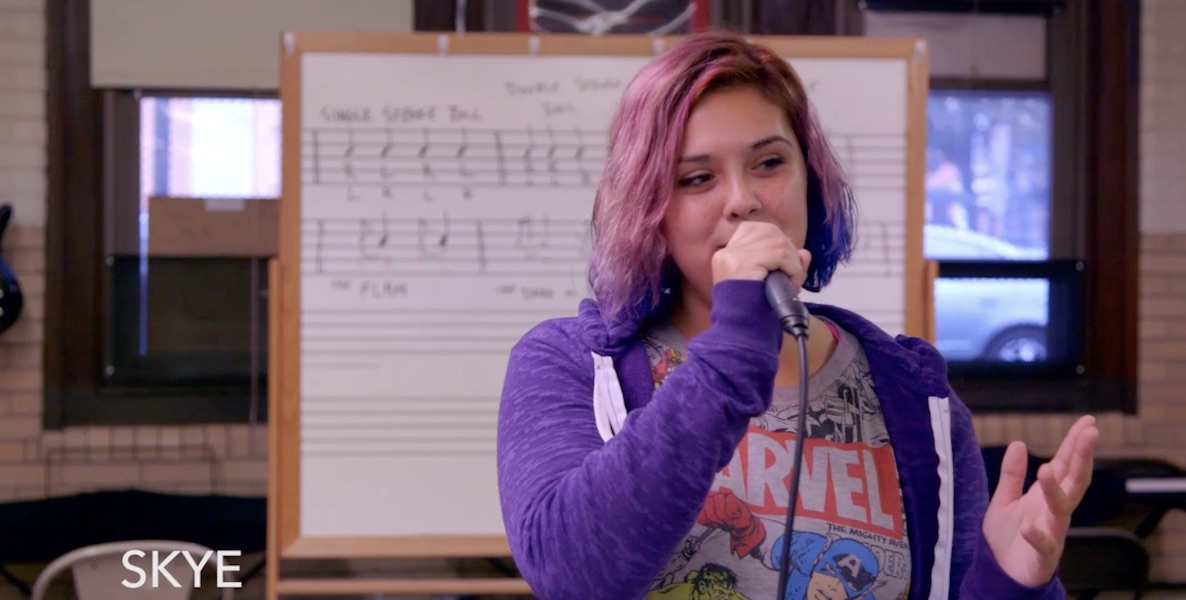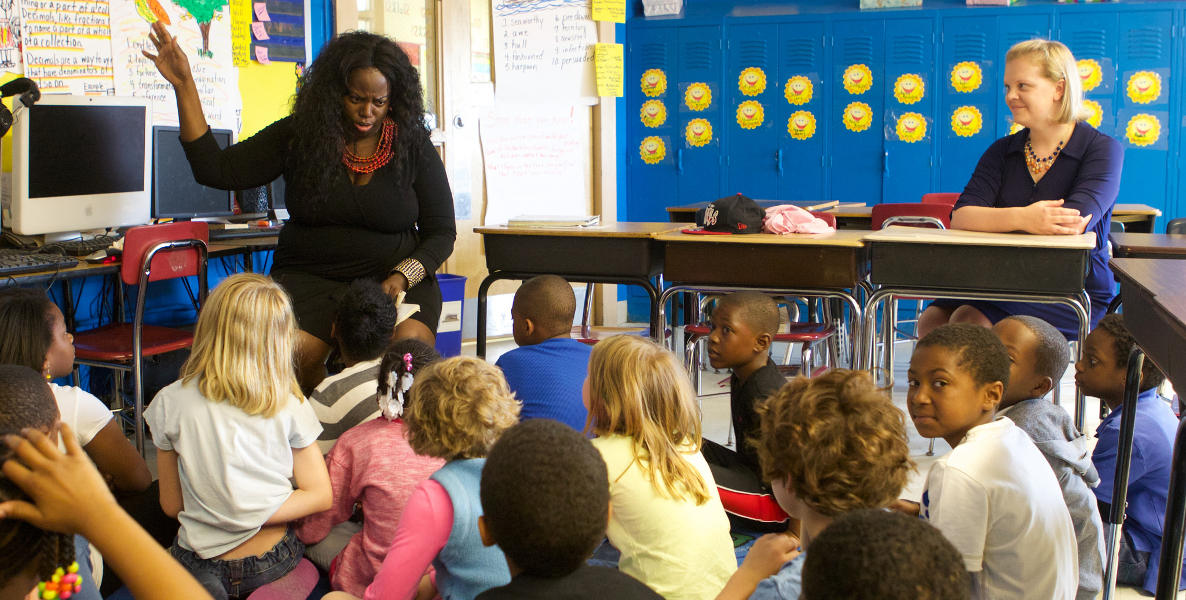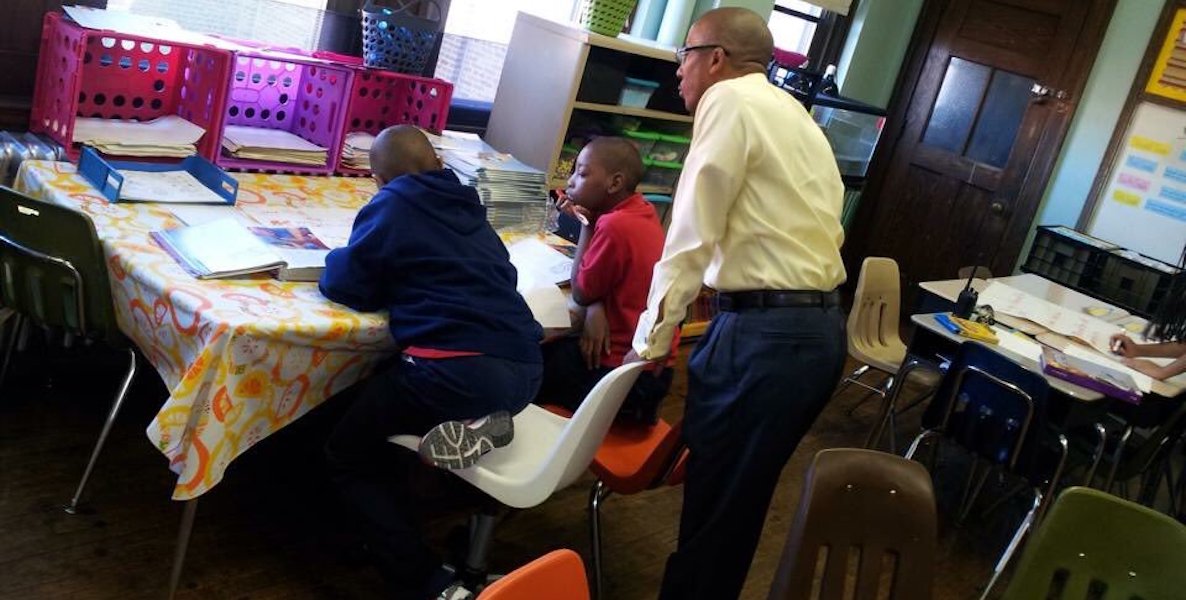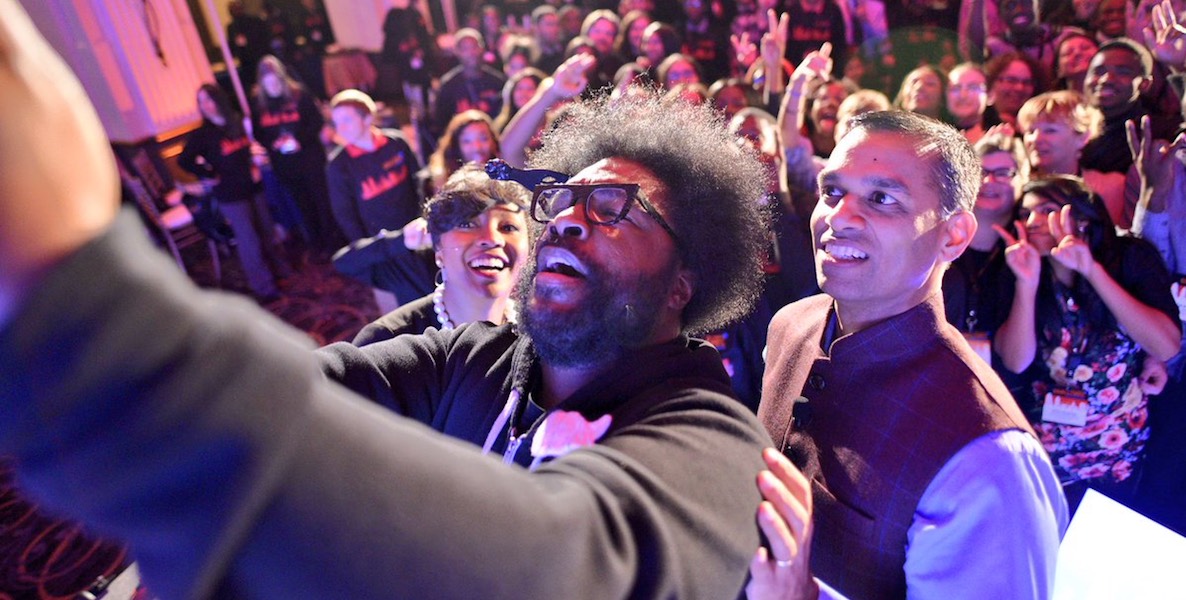It says something about the thrill and enthusiasm of the Aspen Challenge, a real-life problem-solving contest for high school students, that Questlove was not the one who delivered the most inspiring message of the day.
Yes, the 160 students in the room—from charter and neighborhood schools across the city—sat rapt while the Roots drummer talked of his incredible work ethic, how everyone should strive to be “great, not just successful,” and directed them to take one deep breath in through their nose and out through their mouth, an act of meditation that “can save your lives.” And yes, he got a raucous standing ovation as the TV cameras followed him out of the Ballroom at the Ben on Wednesday morning. (Though to be clear, everyone got an ovation; that—and throwing no shade—was one of the rules of the day.)
But the best, most pertinent message came from Komal Ahmad, founder and CEO of Silicon Valley startup Copia, which connects unused food from businesses with nonprofits that feed the hungry: “There has never been a better time in human history to solve the world’s problems.”
Solving the world’s problems is a heavy duty to lay on the shoulders of high school students. But it seems utterly possible for this group of students, and their 40 teacher coaches, who are taking part in the first Philadelphia Aspen Challenge. That is the aim, anyway, of the Challenge, an annual contest run by the Bezos Family Foundation and the Aspen Institute, a forum for ideas and those who have them. The launch of the Challenge yesterday was a celebration of students and their potential, wrapped in the idea that being a problem-solver is not only cool, it can be fun (and, by the way, give you an audience with Questlove).
The launch included inspirational pep talks (besides Questlove, they heard from author and artist MK Asante; Black Lives Matter activist DeRay Mckesson; and National Constitution Center president Jeffrey Rosen), transcendal meditation, spontaneous dance parties, workshops and joyful applause. Throughout, experts presented the group with five serious challenges: Devise a way to change the culture of violence by making non-violence cool (offered by Rev. Jeffrey Brown, founder of Rebuilding Every Community Around Peace); design a scalable way to recover wasted food (Ahmad); empower young people to redefine democracy through participatory budgeting (Shari Davis, director of strategic initiatives at Boston-based Participatory Budgeting Project); empower the community to keep the planet healthy (JT Reager, NASA earth scientist); and encourage healthy habits among young people (Penn bioethicist and vice provost for global initiatives Zeke Emanuel).
Teams of eight students from 20 different schools will each choose one challenge, and spend the next eight weeks devising a solution that is innovative and sustainable. They’ll present their ideas to a panel of judges on March 29th, and the winning team will be invited to next summer’s Aspen Institute, where they will have a chance to hobnob with some of the world’s best thinkers—from Supreme Court Justices to billionaire entrepreneurs to social activists. Having the winning idea, though, is not really the point.
“What’s important is the ripple effect,” says Natalie Travers, program manager for the Aspen Challenge. “Even if they don’t win, those eight students hopefully will have a huge impact on their schools, and neighborhoods, and sometimes even cities. At the end of the day, we want them to continue that work into eternity.”
“What’s important is the ripple effect,” says Natalie Travers, program manager for the Aspen Challenge. “Even if they don’t win, those eight students hopefully will have a huge impact on their schools, and neighborhoods, and sometimes even cities. At the end of the day, we want them to continue that work into eternity.”
The Aspen Challenge was inspired by the Bezos Scholar Program, launched by the Bezos Family Foundation (run by Amazon founder Jeff Bezos’s parents) more than 10 years ago, with support from the Aspen Institute. In 2012, the foundation charged the Institute with scaling the teen program, to reach more youth and make it a fun competition. “The premise has always been reaching young people who have potential,” says Travers. “They believe every single young person does have potential, but often aren’t engaged enough in our society. The question is, how do we reach those who are underserved?”
Starting with the first year in Los Angeles, the Challenge put out an invitation to public schools (including charters) in urban districts, with a high proportion of students who are underprivileged, and that represent the geographic and ethnic diversity of the school district as a whole. In Philadelphia, the schools represent every type of public school, skewing towards general admission high schools. (The academically-strongest magnets—Science Leadership Academy, Masterman, Central—are not among the participants.) Each school selected the eight team members—not necessarily the top of their class, but ones who show leadership potential—and two teachers to guide them. This year, the Institute has also initiated a structured teacher training program to help the coaches incorporate the lessons from the Challenge into their everyday classrooms—that ripple effect again.
Philadelphia is the fifth city to participate in the Aspen Challenge, thanks in large part to former city Commerce Director and Kimmel Center President Stephanie Naidoff, who now sits on the board of the Philadelphia Schools Partnership and the Fund for the School District of Philadelphia. Naidoff spends much of the year in Colorado, and is a fellow of the Aspen Institute. She first learned of the Challenge in its second year, when it was in Denver. She attended the daylong event that year and was blown away; immediately, she started lobbying to bring it to Philly. The Bezos Foundation will fund the contest in Philly for two years; after that, Naidoff hopes the community will keep it going.

Get More From Every Story
We include boxes in nearly every story to help you take action. Click the boxes below to see how you can make Philly better.
“We especially realized how distressing the feeling was in Philadelphia about the schools,” Naidoff says. “I thought this could really help people become devoted to the children. If people in the community can see how magical and inspiring this is, hopefully we will develop a cadre of people who want to continue to do it.”
In past years, similar challenges have produced solutions that rival those of professional experts. The first winner, at a math and science high school in Los Angeles, took on a challenge to teach their peers about the food system. They created a campaign that made it uncool to eat junk food; built a hydroponic farm in their school; and got a grant to build a greenhouse, which the school has since incorporated into the curriculum. Even today, when all the original students are in college, the students use their gardens as teaching tools. “Everyone who goes through will have hands on it, understand what it’s like to grow your own food, and take that lesson back to their homes around the city,” Travers says.
Last year, the winning team from Chicago tackled the issue of empowering their community to understand the financial industry, and how it could work for them. Travers says the students first noticed there were no banks in the school’s neighborhood, only expensive check cashing storefronts. So they held the first of what will be an annual Bank Fair, bringing banks to the neighborhood to help people open accounts. They also wrote a graphic novel about financial literacy, part of a curriculum they call “Money L.Y.F.E—Leading Youth in Financial Education,” which they shared with their classmates, and take to elementary schools around the city to educate younger students.
Naidoff fully expects the same sorts of ideas to emerge from the students in her city, where yesterday’s fanfare was the start of eight weeks of hard work away from the glamour and pomp of the launch. But it is, hopefully, work that will turn dozens of young people—and their friends, and families, and anyone who sees them making a difference—into enthusiastic solvers of problems in their city and beyond. Imagine the difference that could make—young enthusiasts taking on the hardest problems of our time and fixing them, for the good of their communities. That is a beautiful idea, one that we’re witnessing in practice through the Aspen Challenge.
Actually, perhaps Ahmad’s wasn’t the most important message of the day after all. Perhaps that came earlier, during the joyful opening ceremony, when each of the 20 student leaders introduced themselves and their schools, along with the inspirational hashtag they created as their theme for the Challenge. The best one, by People for People Charter School, summed up the feeling of the day: #UnityMakesPhilly.
Header Photo: Questlove takes a selfie with students at the Philadelphia Aspen Challenge launch. Photo by Dan Bayer





